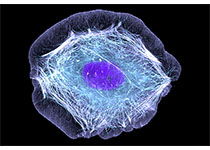Recently, Yuxing, Chen and Congzhao, Zhou, professors of National Research Center for Microscale Material Science and Department of Life Science and Medicine of University of Science and Technology of China, collaborated with Linfeng Sun’s group to analyze the near-atomic resolution 3D structure of human lysosomal vitamin B12 efflux protein ABCD4 using cryo-EM technology for the first time, providing a basis for in-depth understanding of the molecular mechanism of this type…
cryoET
New Research Reveals The Structure of Key Electrical Switches in The Brain

Scientists have revealed the structure of key receptors in the brain that are involved in learning, memory, behavior, and mood. The new study published in the journal of Science reveals the structure of the AMPA receptor in its natural state for the first time. This discovery will bring new ideas to uncover the mechanisms behind a series of neurological disorders and diseases. “There are some basic electrical switches in…
A New Study Analyzed The Structure of The Important Photosynthetic Membrane Protein Super Complex of Pseudomonas Aeruginosa

Recently, a team led by academician of the Chinese Academy of Sciences, researcher of the Institute of Botany, Chinese Academy of Sciences, Tingyun Kuang, and researcher Jianren Shen cooperated with researchers from Jinan University and Tsinghua University revealed an important photosynthetic membrane protein super complex of Pseudomonas aeruginosa – photosystem I light-harvesting complex. I. (PSI-LHCI) 3.49 resolution structure. This study further improved the understanding of the trend of light system…
A Study Discover New Targets for Targeting Caliciviruses

Norovirus is highly contagious and very difficult to control. In general, the Norovirus epidemic broke out in hospitals, nursing homes, schools, hotels, and cruise ships. Calicivirus, including Norovirus and sapovirus, is also an important animal pathogen, leading to ‘cat flu’ associated with high mortality in domestic cats. In a new study, British researchers used cryo-electron microscopy to study the structure of the feline calicivirus that causes cat flu to better…
Cell: New Research Reveals an Unexpected Mechanism of Action of Antibodies

In a new study, researchers from research institutions such as the University of Washington in the United States studied monoclonal antibodies which were isolated from survivors of the severe acute respiratory syndrome (SARS) or Middle East Respiratory Syndrome (MERS) caused by the coronavirus. These monoclonal antibodies reveal an alarming immune defense strategy against deadly viruses. Atomic and molecular information for these highly potent antibodies may provide new insights into these…
New Study Analyze The High-resolution Three-dimensional Structure of The Virus Coxsackie A10

A research report published in the Journal of Nature Communications reveals the full-particle atomic resolution structure of the three different life cycles of the hand-foot-and-mouth virus Coxsackie A10 (CVA10) and the medium-resolution genomic structure of the capsid intermediate completed by the researcher in the Institute of Biophysics, Chinese Academy of Sciences, which is another important research result after they completed the study of the full-particle structure and function of the…
Nature: Tc Toxin Activation Requires Unfolding and Refolding of a β-Propeller

Bacteria have established strategies for infecting organisms and utilize them as a source of nutrients. Many bacteria use their secreted toxins to simply pierce the outer shell of the cell to destroy the cell membrane. Human pathogens such as Yersinia pestis or other bacteria from Salmonella produce a more subtle mechanism: injecting their toxic substances by using a special toxin complex. Bacterial toxins are one of the most effective…
Nature: Malaria Parasite Translocon Structure and Mechanism of Effector Export

Malaria is an infectious disease that is transmitted to people through the bite of mosquitoes infected with Plasmodium. It affects more than 200 million people each year and kills nearly half a million people each year. When bitten by a mosquito, the Plasmodium invades human erythrocytes, acquires a portion of the erythrocyte membrane, and forms a protective compartment around it, known as a vacuole. Normal red blood cells…
Nature: Inositol Phosphates Are Assembly Co-factors for HIV-1

In a new study, researchers from Cornell University, the University of Virginia, the University of Delaware, the University of Missouri, the German European Molecular Biology Laboratory, and the Austrian Institute of Science and Technology provided new details of how the HIV-1 viral structure is assembled. This discovery provides a potential new target for the treatment of this viral infection. The relevant research results were published online in Nature. This…
Cryo-EM Structure of Plasmodium Vivax Invasion Revealed

Plasmodium invades the body’s young red blood cells, which then begin to spread throughout the body. In a new study, researchers from Australia and the United States used cryo-electron microscopy (cryo-EM) to reveal for the first time at the atomic level a three-dimensional picture of how Plasmodium vivax invades human red blood cells. They mapped out the first contact between the Plasmodium and the young red blood cells they are…
